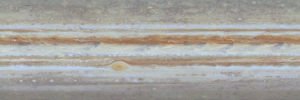Juno (spacecraft)
Template:Infobox Spacecraft
Juno is a NASA New Frontiers class mission led by Dr. Scott Bolton to the planet Jupiter. It was originally proposed at a cost of approximately USD $700 million (FY03) for a June 2009 launch. NASA budgetary restrictions resulted in Juno being re-scheduled to launch in August 2011.[1] In September 2008, the mission officially moved to the Phase C stage of development. The Atlas V rocket has been chosen to launch Juno in the Atlas V-551 configuration.
The spacecraft will be placed in a polar orbit to study the planet's composition, gravity field, magnetic field, and polar magnetosphere. Juno will also search for clues about how Jupiter formed, including whether the planet has a rocky core, the amount of water present within the deep atmosphere, and how the mass is distributed within the planet. Juno will also study Jupiter's deep winds, which can reach speeds of 600 km/h.
Mission summary
Juno's trajectory will use a gravity assist speed boost from Earth, accomplished through an Earth flyby two years after its 2011 launch. In 2016, the spacecraft will perform an orbit insertion burn to slow the spacecraft enough to allow capture into an 11-day polar orbit. Once Juno enters into its orbit, infrared and microwave instruments will begin to measure the thermal radiation emanating from deep within Jupiter's atmosphere. These observations will complement previous studies of the planet's composition by assessing the abundance and distribution of water, and therefore oxygen. While filling missing pieces of the puzzle of Jupiter's composition, this data also provides insight into the planet's origins. Juno will also investigate the convection that drives general circulation patterns in Jupiter's atmosphere. Meanwhile, other instruments aboard Juno will gather data about the planet's gravitational field and polar magnetosphere.[2]
The Juno mission will conclude in 2018, after 32 orbits around Jupiter. Data analysis may continue beyond 2018.
Scientific objectives
The Juno spacecraft's suite of seven science instruments will determine:
- The ratio of oxygen to hydrogen, effectively measuring the abundance of water in Jupiter, which will help distinguish among prevailing theories linking the gas giant's formation to the solar system.
- Obtain a better estimate of Jupiter's core mass, which will also help distinguish among prevailing theories linking the gas giant's formation to the solar system.
- Precisely map Jupiter's gravity to assess the distribution of mass in Jupiter's interior, including properties of the planet's structure and dynamics.
- Precisely map Jupiter's magnetic field to assess the origin and structure of the field and how deep in Jupiter the magnetic field is created. This experiment also will help scientists understand the fundamental physics of dynamo theory.
- Map the variation in atmospheric composition, temperature, structure, cloud opacity and dynamics to depths far greater than 100 bars at all latitudes.
- Characterize and explore the three dimensional structure of Jupiter's polar magnetosphere and its auroras.[3]
The team
Dr. Scott J. Bolton of the Southwest Research Institute in San Antonio, Texas is the Principal Investigator and is responsible for all aspects of the mission. The Jet Propulsion Laboratory in California manages the mission and Lockheed Martin Corporation is responsible for the spacecraft development.
Proposed scientific instruments


The Juno mission's science objectives will be achieved with a payload of seven instruments onboard the spacecraft:[4]
- Microwave Radiometer (MWR)
- Jovian Infrared Auroral Mapper (JIRAM)
- Advanced Stellar Compass (ASC)
- Jovian Auroral Distribution Experiment (JADE)
- Energetic Particle Detector Instrument(JEDI)
- Radio and Plasma Wave Sensor(WAVES)
- Ultraviolet Imaging Spectrograph (UVS)
- JunoCam
Solar panels
It will be the first mission to Jupiter using solar panels instead of the radioisotope thermoelectric generators (RTGs) used by Pioneer 10, Pioneer 11, the Voyager program, Cassini–Huygens, and the Galileo orbiter. Advancement in solar cell technology and efficiency over the past several decades now makes it economically feasible to use solar panels of practical size to provide power so far from the Sun. In addition, RTGs are in short supply, limiting their availability for space missions. Also, by using solar energy, NASA avoids the protests associated with launching RTGs into space (due to accusations of public safety risks, which NASA refutes in detailed scientific reports); however, it should be noted that NASA plans several more projects involving RTGs,[5] and the decision to use alternate technology on this mission is more practical and economical than political.
The Juno spacecraft uses three, 2 m x 9 m solar panels that will remain in sunlight continuously from launch through end of mission, except for a 10-minute period during the Earth gravity assist flyby. These panels will produce at least 1kW of power for the instruments when in Jupter's orbit.
Atmosphere of Jupiter
Jupiter is a giant gas planet and does not have a solid surface. The atmosphere of Jupiter can be divided into four layers: the troposphere, stratosphere, thermosphere and exosphere. Unlike the Earth's atmosphere, Jupiter's lacks a mesosphere, and the lowest atmospheric layer, the troposphere, smoothly transitions into the planet's fluid interior.[6] This is a result of having temperatures and the pressures well above those of the critical points for hydrogen and helium, meaning that there is no sharp boundary between gas and liquid phases.[6]
References
- ^ "Juno - NASA's Second New Frontiers Mission to Jupiter". Retrieved 2007-10-24.
- ^ "Juno: A unique spacecraft on a critical mission". Retrieved 2008-10-13.
- ^ "Juno Science Objectives". University of Wisconsin-Madison. Retrieved 2008-10-13.
- ^ "Instrument Overview". Wisconsin University-Madison. Retrieved 2008-10-13.
- ^ "Enabling Exploration: Small Radioisotope Power Systems". NASA. Retrieved 2007-10-24.
- ^ a b Guillot, Tristan (1999). "A comparison of the interiors of Jupiter and Saturn". Planetary and Space Sciences. 47: 1183–1200. doi:10.1016/S0032-0633(99)00043-4.
See also
- Atmosphere of Jupiter
- Comet Shoemaker-Levy 9
- Moons of Jupiter
- Exploration of Jupiter
- Pioneer 10
- Pioneer 11
- Voyager 1
- Voyager 2
- Cassini probe
- New Horizons
- Galileo
- Ulysses (spacecraft)


